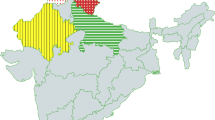Abstract
Cucumis melo L. (melon) genotypes differ widely in morphological and biochemical traits. Intraspecific classification of such variability has been difficult, and most taxonomists still rely on the work of Naudin (1859). A collection of 54 accessions representing diverse genotypes from 23 countries was surveyed. Morphological traits related to the vegetative and flowering stages and mature fruit morphology and quality parameters, e.g., taste, aroma, sugar composition and pH, were scored. These were used to construct a “botanical-morphological” dendrogram that generally reflected the classification ofCucumis melo into several horticultural varieties. DNA polymorphism among the accessions was assessed using the Inter-SSR-PCR and RAPD techniques that detected abundant DNA polymorphism among melon genotypes. Cluster analysis indicated that the largest divergence was between North American and Europeancantalupensis andinodorus cultivars as one group, and the more “exotic” varieties:conomon, chito, dudaim, agrestis andmomordica, as a second group. The molecular phylogeny agreed, broadly, with the classification of melon into two subspecies, and did not contradict the division into “horticultural varieties”. It was apparent, however, that the infra-specific division is rather loose, molecular variation being distributed continuously between and within cultivar groups. We suggest that despite the morphological diversity, separation between varietal-groups may be based on a too small number of genes to enable unambiguous infra-specific classification based on DNA diversity.
Similar content being viewed by others
References
Bates D. M., Robinson R. W. (1995) Cucumbers, melons and watermelons. In: Smartt J., Simmonds N. W. (eds.) Evolution of crop plants, 2nd edn. Longman Scientific, Essex, pp. 89–96.
Berger S. L., Kimmel A. R. (1986) DNA fingerprinting by oligonucleotide probes specific for simple repeats. Hum. Genet 74: 239–243.
Campos L. P., Raelson J. V., Grant W. F. (1994) Genome relationships amongLotus species based on random amplified polymorphic DNA (RAPD). Theor. Appl. Genet. 88: 417–422.
Dellaporta S. L., Wood J., Hicks J. B. (1983) A plant DNA minipreparation: version II. Plant Mol. Biol. Reporter 1: 19–21.
Esquinas-Alcazar J. T., Gulik P. J. (1983) Genetic resources ofCucurbitaceae: a global report. IBPGR Secretariat, Rome.
Fang, D. Q., Roose M. L. (1997) Identification of closely related citrus cultivars with inter-simple sequence repeat markers. Theor. Appl. Genet. 95: 408–417.
Felsenstein J. (1993) PHYLIP (Phylogeny Inference Package), Version 3.5c, distributed by the author, Department of Genetics, University of Washington, Seattle.
Grebenscikov I. (1953) Die Entwicklung der Melonsystematik. Kulturpflanze 1: 121–138.
Gupta M., Chyi Y.-S., Romero-Severson J., Owen J. L. (1994) Amplification of DNA markers from evolutionarily diverse genomes using single primers of simple-sequence repeats. Theor. Appl. Genet. 89: 998–1006.
Hallden C., Hansen M., Nilsson N. O., Hjerdin A., Sall T. (1996) Competition as a source of errors in RAPD analysis. Theor. Appl. Genet. 93: 1185–1192.
Hammer K., Hanelt P., Perrino P. (1986)Carosello and the taxonomy ofCucumis melo L. especially of its vegetable races. Kulturpflanzen 34: 249–259.
Hoey B. K., Crowe K. R., Jones V. M., Polans N. O. (1996) A phylogenetic analysis ofPisum based on morphological characters, allozyme and RAPD markers. Theor. Appl. Genet 92: 92–100.
Jeffrey C. (1980) A review of theCucurbitaceae. Botanical Journal of the Linnean Society 81: 233–247.
Kirkbride J. H. (1993) Biosystematic monograph of the genusCucumis (Cucurbitaceae). Parkway Publishers, North Carolina.
Lee S. J., Shin J. S., Park K. W., Hong Y. P. (1996) Detection of genetic diversity using RAPD-PCR and sugar analysis in watermelon (Citrullus lanatus (Thunb.) Mansf.) germplasm. Theor. Appl. Genet. 92: 719–725.
Mallick M. F. R., Masui M., 1986: Origin, distribution and taxonomy of melons. Scientia Hort. 28: 251–261.
Millan T., Osuna F., Cobos S., Torres A. M., Cubero J. I. (1996) Using RAPDs to study phylogenetic relationships inRosa. Theor. Appl. Genet. 92: 273–277.
Munger H. M., Robinson R. W. (1991) Nomenclature ofCucumis melo L. Cucurbit Genet. Coop. Reports 14: 43–44.
Naudin C. V. (1859) Essais d'une monographie des espèces et des variétés du genreCucumis. Ann. Sci. Nat. Bot. sér. 4, 11: 5–87.
Neuhausen S. L. (1992) Evaluation of restriction fragment length polymorphism inCucumis melo. Theor. Appl. Genet. 83: 379–384.
Pangalo K. J. (1929) Critical review of the main literature on the taxonomy, geography and origin of cultivated and partially wild melons. — Trudy Prikl. Bot. 23: 397–442 [In Russian, and translated into English for USDA by G. Saad in 1986].
Perl-Treves R., Zamir D., Navot N., Galun E. (1985) Phylogeny ofCucumis based on isozyme variability and its comparison with plastome Phylogeny. Theor. Appl. Genet. 71: 430–436.
Pitrat M. (1991) Linkage groups inCucumis melo L. J. Hered. 82: 406–411.
Schierwater B. (1995) Arbitrary amplified DNA in systematics and phylogenetics. Electrophoresis 16: 1643–1647.
Silberstein L., Kovalski I., Huang R., Anagnostou K., Kyle M. M., Perl-Treves R. (1999) Molecular variation inCucumis melo as revealed by RFLP and RAPD markers. Scientia Horticulturae 79: 101–111.
Staub J., Jeffrey B., Poetter K. (1996) Sources of potential errors in the application of random amplified polymorphic DNA in cucumber. HortScience 31: 262–266.
Staub J., Box J., Meglic V., Horejsi T. F., McCreight J. D. (1997) Comparison of isozyme and random amplified polymorphic DNA data for determining intraspecific variation inCucumis. Genet Res. Crop Evol. 44: 257–269.
Stepansky A., Kovalski I., Schaffer A. A., Perl-Treves R. (1999) Variation in sugar levels and invertase activity in mature fruit representing a broad spectrum ofCucumis melo genotypes. Genet Res. Crop Evol. 46: 53–62.
Swofford D. L. (1993) PAUP: Phylogenetic Analysis Using Parsimony, Version 3.1, Computer program distributed by the Illinois Natural History Survey, Campaign, Illinois.
Virk P. S., Ford-Lloyd B. V., Jackson M. T., Newbury H. J. (1995) Use of RAPD for the study of diversity within plant germplasm collections. Heredity 74: 170–179.
Walters T. W. (1989) Historical overview on domesticated plants in China with special emphasis on the Cucurbitaceae. Econ. Bot. 43: 297–313.
Whitaker T. W., Davis G. N. (1962) Cucurbits — botany, cultivation and utilization. London Leonard Hill Ltd., Interscience Publishers Inc., New York.
Williams J. G. K., Hanafey M. K. Rafalsky J. A., Tingey S. V. (1993) Genetic analysis using random amplified polymorphic DNA markers. Methods in Enzymology 218: 704–741.
Zietkiewicz E., Rafalski A., Labuda D. (1994) Genome fingerprinting by simple sequence repeat (SSR)-anchore PCR amplification. Genomics 20: 176–183.
Author information
Authors and Affiliations
Rights and permissions
About this article
Cite this article
Stepansky, A., Kovalski, I. & Perl-Treves, R. Intraspecific classification of melons (Cucumis melo L.) in view of their phenotypic and molecular variation. Pl Syst Evol 217, 313–332 (1999). https://doi.org/10.1007/BF00984373
Received:
Accepted:
Issue Date:
DOI: https://doi.org/10.1007/BF00984373




